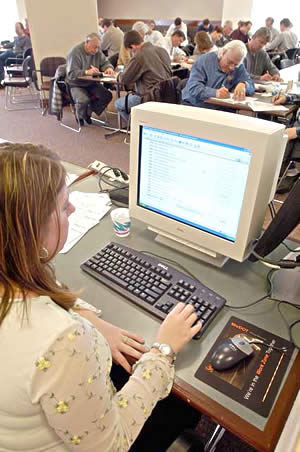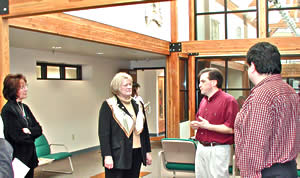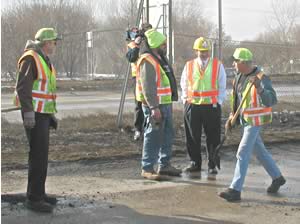 |
 |
|
 |
Mn/DOT
lets its first ‘bond-accelerated projects’ |
 |
 |
 |
|
Rebecca Pula, Office of Construction,
records bid information during the Feb. 27 bid letting
at the Central Office. Photo by David Gonzalez
|
Mn/DOT lets its first two bond-accelerated projects on Feb.
27 when apparent low bids were accepted for the first stage
of the I-35E/I-694 “Unweave the Weave” project
in the Twin Cities metro area and rebuilding Hwy 14 between
Janesville and Waseca.
The two projects number among 12 projects included in the Transportation Finance
Bill passed last year by the Minnesota Legislature. Both projects will increase
safety and mobility, two of the legislation’s major goals.
The bill provided $400 million in state bonds for highway construction.
Combined, the 12 projects will save more than 65 years in construction delays
and an estimated $140 million in project inflation costs.
“Minnesota is continually faced with improving our transportation infrastructure,”
said Gov. Tim Pawlenty. “Because of the good work of Lt. Gov. Carol Molnau
at the Department of Transportation, we are able to speed up several long-term
projects that will improve safety and mobility for Minnesota drivers.”
The low bid to reconstruct the I-35E/I-694 interchange. was from Lunda Construction
at $3,212,867. This project is being accelerated by four years. It will eliminate
the currently dangerous weaving movements at that interchange, improve safety
and improve travel times through the area. Construction, originally scheduled
to begin in 2008, will start in mid-April.
The low bid to reconstruct Hwy 14 between Janesville and Waseca in southern
Minnesota was from Mathiowetz Construction Co. at $34,263,131. The project is
the largest ever constructed in Mn/DOT’s Mankato District. This interregional
corridor will be expanded from two to four lanes, which will improve safety
and mobility. Construction of the Hwy14 project will begin in May and is expected
to be completed in 2006, three years earlier than previously scheduled.
"The beginning of these critical construction projects this spring is
another important step in ensuring that Minnesota continues to have one of the
safest and most efficient highway systems in the nation,” said Molnau.
By Donna Lindberg
|
back

|
 |
Congress, President OK second TEA-21 extension |
 |
 |
On Friday, Feb. 27, Congress passed and President Bush signed
a two-month extension of the Transportation Equity Act for
the 21st Century. An earlier, five-month extension of TEA-21,
enacted by Congress last year, expired Feb. 29. This second
extension of federal funding for transportation extends through
April 30.
Both the U.S. Senate and House of Representatives have drafted
bills to replace TEA-21. The House’s proposed bill totals
$375 billion, the Senate’s $318 billion. The President
has threatened to veto any bill agreed upon by both the House
and Senate that exceeds $270 billion.
Until a bill is agreed upon, Mn/DOT is making its programming
forecasts based on the Senate’s $318 billion SAFE-TEA
bill.
“Out of a $318 billion bill, Minnesota’s share
is $472 million for new projects and to pay off our bond projects,”
said Frank Van De Steeg Director of Innovative Finance in
Mn/DOT’s Office of Investment Management. “There
is a better chance that the Senate bill will get passed because
it is a middle-of-the-road bill that all sides are most likely
to agree to. Mn/DOT could get as much as $550 million with
the Senate bill because it fixes a current ethanol tax problem.”
Betsy Parker, Mn/DOT’s director of Government Affairs,
and Bob Hofstad, Director of the Program Development Section,
OIM, attended a reception for the Minnesota Congressional
delegation in Washington D.C. last week. Many national transportation
organization representatives, Congressional staff and contractor
and consultant organizations attended the reception to encourage
the passage of a long-term reauthorization of TEA-21.
If a long-term transportation bill is not passed before April
30 there may not be an action on this issue until after the
presidential elections in November. A third extension may
then be needed.
Further extensions could spell trouble for Mn/DOT.
“Lack of action on a reauthorization bill could delay
or stop bonding projects,” said Hofstad. “Conversion
of federal advance construction dollars in a timely manner
is an integral part of making the 2003 Pawlenty-Molnau transportation
funding package work.”
Cities, counties and private contractors could also feel
the pinch.
“If we don’t have a long-term bill soon, the
biggest impact could be on local governments that don’t
have projects authorized,” said Van De Steeg. “And
if extensions don’t provide the funding necessary for
current projects, Mn/DOT could be faced with paying contractors
with cash on hand, with no timely reimbursement from the federal
government.”
Reauthorization of TEA-21 would be good news, but none of
the current proposals completely address Minnesota’s
long-term funding needs.
“What is really needed is an increase in overall transportation
funding, said Hofstad. ”
For more information about the TEA-21 reauthorization bill,
visit the AASHTO Web site at http://www.transportation.org/aashto/press.nsf/by+Date+Public?openview
By Donna Lindberg
|
back

|
 |
Visits by Mn/DOT officials to tribal reservations promote increased cooperation |
 |
 |
 |
|
Flanked by Linda Aitkin, Mn/DOT's
tribal liaison, Lt. Gov./Commissioner Carol Molnau meets
with Chuck Walt, health clinic assistant director, and
Jason Hollinday, tribal economic development planner,
at the Fond Du Lac Reservation's health center. Photo
by John Bray
|
With her Feb. 24 visit to the Fond du Lac Reservation near Duluth, Lt. Gov./Commissioner
Carol Molnau completed on-site meetings with tribal leaders from all of the
state’s federally recognized Indian tribes.
Molnau met personally with tribal leaders as part of Mn/DOT’s outreach
effort to tribal governments to examine ways each entity can support mutual
goals related to transportation.
Mn/DOT officials began their dialogue with the tribes with the first Tribes
and Transportation conference held in April 2002. A second conference was held
last year.
The conferences produced agreements of mutual support and cooperation by federal,
tribal and state government officials.
The agreements have led to ongoing development of a handbook and a Web site
to enable tribal and other government officials to work more effectively together,
a joint effort by Willmar/District 8 and the Upper Sioux Community at Granite
Falls to plan for future transportation needs and the series of visits by Molnau;
Linda Aitkin, Mn/DOT’s tribal liaison, and Al Steger, regional FHWA division
administrator, and other officials to the reservations.
Recently, Aitkin said, Mn/DOT and tribal officials resolved issues related
to signing for two tribally operated casinos.
“The visits and resulting dialogue have been very valuable,” Aitkin
said. “We’ve had a lot of involvement by the tribes and we continue
to build partnerships to continue our work together.”
By Craig Wilkins
|
back

|
 |
Perennial plethora of pothole plagues state’s highways |
 |
 |
 |
|
A Metro District maintenance crew
including Bob Lavone and Ed Boyd, Arden Hills, describes
its pothole patching chores to Jason DeRusha, a WCCO-TV
news reporter who reported on the pothole outbreak.
Photo by Kent Barnard
|
As surely as spring follows winter, potholes form as the weather warms to plague
the state’s highway system. This year the pothole menace started earlier
and more intensely after other cold, heavy snowfalls and a rapid warm-up in
February did their dirty work.
In response, Mn/DOT maintenance crews quickly switched from plowing snow to
patching potholes by the thousands.
Techniques vary from automated patchers used in the Twin Cities and St. Cloud
to the tried and true method of filling potholes with patching material and
tamping it down by hand.
Mn/DOT crews in areas such as the Twin Cites and St. Cloud use the automated
patcher because of its suitability for high-traffic areas.
The automated process employs a truck- or trailer-mounted boom. The driver/operator
blows compressed air through a long tube to clean out the pothole then fills
it with the precise amount of patching material needed. The automated operation
saves time and money and improves safety by reducing the exposure of highway
workers to traffic.
Mn/DOT’s standard response, however, is not the department’s only
approach to the pothole problem.
When the warmer spring weather arrives, the freeze/thaw cycle accelerates,
causing pavement to deteriorate even more quickly. Mark Wikelius, Mn/DOT’s
state maintenance engineer, said the key to the problem not becoming too much
of a nuisance is speedy repairs.
Crews throughout the state now use improved pothole filling materials that
resist moisture and bond with the pavement more effectively to provide a longer-lasting
repair.
Mn/DOT initiatives to reduce the prevalence of potholes include its preventive
maintenance program. Preventive maintenance involves constant pavement monitoring
to identify sections of roadway most prone to potholes, rutting, cracking and
other damage.
Problem areas are then scheduled for resurfacing or other repairs to minimize
future damage to the roadway.
Resurfacing techniques include methods such as micosurfacing. That process
uses a mixture of an emulsion, a mineral such as Portland cement and aggregate.
The mixture sets up quickly and incorporates existing water into its chemical
reaction or curing. Microsurfacing provides a surface repair that will last
until more extensive repairs are needed.
Other treatments include traditional crack filling done by hand and applying
seal coats, thin layers of asphalt that provide a smooth riding surface.
Mn/DOT’s long-range efforts to extend pavement life include its growing
use of Superpave, a high-performance asphalt pavement design that shows potential
to resist damage caused by the freeze/thaw cycle and the extremes in temperature
that damage pavement.
Mn/DOT also recently joined with the University of Minnesota to lead a national
research effort to develop crack-resistant asphalt paving materials that would
eliminate potholes and other pavement failures.
“We’re attacking potholes on several fronts,” Wikelius said.
“In the short term, we’re using methods such as the automated patcher
to make repairs as quickly as possible. In the long term, we are expanding our
use of Superpave and other advanced pavement designs that we hope will greatly
reduce the potential for damage such as potholes to develop.”
By Craig Wilkins
|
back

|
 |
Metro Transit bus strike starts Thursday |
 |
 |
Metro Transit bus drivers are set to go on strike at 2 a.m. on Thursday, March
4. Mn/DOT’s Regional Traffic Management Center will monitor potential
impacts on traffic. Congestion information will appear on their traffic map
at www.511mn.org.
For advice on other commuting options, visit Metro Transit’s Web site
at www.metrotransit.org. The site
provides info on routes operated by suburban providers
and private contractors, carpool matching services and information about the
31-day pass and Metropass users. The Metropolitan Council offers an interactive
rideshare program at www.metrocommuterservices.org.
A rideshare board is at www.twincities.com.
For a list of other bus providers into downtown St. Paul, go to www.saintpaulparking.com.
|
back

|
 |
Interactive CDs helps designers get ‘virtual’ hands-on training |
 |
 |
 |
|
Gene Olchefske, team leader, and
Dave Sundberg (sitting), prepare one of the CDs in the
design training program. Photo by David Gonzalez
|
Chances are good that you won’t find them at Target or Sam Goody’s,
but the training CDs made by Mn/DOT are a Top 40 hit with design engineers and
technicians nationwide.
That’s actually the “Top 34,” the number of the interactive
compact discs produced by Gene Olchefske and Dave Sundberg, Workforce Development,
since the project started in 1999. (Another team member, Karen Kimble, left
Mn/DOT in December.)
Impetus for the project stems from the need for a way to help the complexities
of geometric design be grasped easily and quickly by engineers, highway technicians
and other designers.
Mike Christensen, assistant district engineer at Metro, said the need was first
identified during a quality improvement session in the 1990s.
With support from Mn/DOT and 23 other states, production on the CD-based lessons
got under way in 1999. Olchefske said each of the self-paced lesson addresses
a design issue such as vertical alignments, clear zones, sight distances and
computing quantities of fill and other materials.
Since the CDs first became available, they have been used in nearly every state
to provide what, Christensen an early backer of the effort, calls “just
in time” training.
The CDs, Olchefske said, provide a “look at design as it would look in
real life by using 3D animation. We try to build in a lot of interactive pieces
to keep the training interesting and fun.”
Use of the CDs far exceeds its original intention. They are now also used to
illustrate proposed projects at public meetings, train people entering the TSS
classification and provide quick tutorials for experienced designers. They also
help prepare people to use GeoPak, Mn/DOT’s standard design software program.
Lynnete Roshell, now a project engineer with State Aid, said the CDs help designers
apply engineering theory to practical applications.
Roshell’s former design squad at Golden Valley was involved in the QI
training that led to development of the CD series.
“The training teaches design standards and how they interact, for example,
when designing an intersection. The CDs also help explain the ‘why’
behind the ‘how’ of design,” she said.
Cathy Walz, director of Workforce Development, said the training has become
valuable tool for DOTs nationwide.
“States and local governments are just realizing the potential of electronic
learning and multi-media, Web-based technologies that can deliver high quality,
cost effective training to learners at their desktops,” Walz said.
“Response to this training resource has received extremely positive feedback
internally and from DOTs nationwide,” she said. “Through a partnership
with the Center for Transportation Studies, the CD series will soon be available
to cities and counties.”
To learn more about the training, contact Olchefske at 651/628-6800 or Walz
at 651/296-3101.
By Craig Wilkins
|
back

|
 |
Mn/DOT and Ford to test in-vehicle road condition sensors |
 |
 |
Mn/DOT and Ford Motor Company have partnered to test a new traveler information
system that will relay information right from the source of potential problems
– the road. By the end of the year, 15-20 Minnesota State Patrol vehicles
will be equipped with sensors that collect and transmit traffic information,
speed, location and other data to Mn/DOT’s Condition Acquisition and Reporting
System (CARS) and eventually to the 511 system. Weather-related data can also
be obtained from sensors, including windshield wiper operation, lights on or
off, outside temperature and traction control system status.
“Vehicles will become sensors on the roadway, gathering instantaneous
roadway conditions and sharing this information with each other and our traffic
management systems,” said Jim Kranig, Assistant State Traffic Engineer
and formerly with Mn/DOT’s Office of Intelligent Transportation Systems.
“The sensors will be tested first in State Patrol cars in the Twin Cities
Metro area,” Kranig said. “If they prove to be effective, they may
eventually be installed in Mn/DOT maintenance and Freeway Incident Response
Team vehicles.”
Mn/DOT and Ford are working together and sharing the costs of the project.
Similar fleets are also under development in Dearborn Heights, Mich., and on
the Ford campus in Dearborn, Mich.
“Because of our dramatic changes in seasons, there is a genuine need for
travelers to know as much as possible about the road before they travel,”
said Ginny Crowson, in Mn/DOT’s Office of Traffic, Security and Operations.
“If we can successfully collect and transmit the data from the vehicles,
we can use it to provide better, more accurate traveler information.”
By Donna Lindberg
|
back

|
 |
New online service combines catalogs from transportation libraries to improve
information access |
 |
 |
In the field of transportation, locating a needed report, article or book has
never been an easy task.
For years, the only index to these resources has been the Transportation Research
Information System database compiled by the Transportation Research Board. However,
transportation practitioners, especially those without access to experienced
librarians, often found it difficult to get the full text of an item indexed
in the TRIS database.
All that changed March 1 with the launch of TransCat, a new online service
that makes the catalogs of many of the nation’s largest transportation
libraries—including Mn/DOT’s—available to anyone with access
to the Internet.
With nearly 300,000 resources listed in TransCat, the database is second in
size only to TRIS in covering transportation resources. Unlike TRIS, which is
an indexing service, TransCat catalogs only available resources owned by participating
libraries. This means that nearly all of the resources found when searching
the database can be readily located and made available to the user.
Although many of the items in TransCat are also listed in TRIS, a recent study
showed that 52 percent of recent reports available within TransCat were not
indexed in TRIS. (See http://www.dot.state.mn.us/library/mtkn.html
for more information on the study.)
Midwest transportation librarians have been working with OCLC (www.oclc.org/about),
the world’s largest consortium of libraries, since 2001 to develop TransCat.
The National Transportation Library provides start-up funds for the service.
Click here
to use TransCat.
By Jerry Baldwin, Mn/DOT Library director
|
back

|
 |
Aviation art contest stresses safety theme |
 |
 |
All aspects of transportation safety are important at Mn/DOT, but people may
not always consider how aeronautics may contribute to making lives safer. Young
people ages 6 to 17 years did recently when they entered the 2003 International
Aviation Art contest based on the theme “Flying Saves Lives.” The
Minnesota winners received awards at an official ceremony held Feb. 23 in the
State Capitol Rotunda. Ray Rought, director of Mn/DOT’s Office of Aeronautics,
was the keynote speaker.
“The magnificent artwork of the students symbolizes the various ways
that flying saves lives,” Rought said. “This annual contest also
helps participants explore the many exciting and creative opportunities in aviation.”
In Minnesota, the first through fourth place pieces of artwork in each age
category will be featured in the International Aviation Art contest calendar
for 2005. Winning entries also receive a gift certificate for art supplies and
a 30-minute flight at their local airport.
The contest is hosted by the Office of Aeronautics, the Federal Aviation Agency,
the National Association of State Aviation Officials and the National Aeronautic
Administration, in cooperation with the Federation Aeronautique Internationale.
The Minnesota winning entries can be viewed on the Mn/DOT Office of Aeronautics
Web site at www.dot.state.mn.us/aero/aved/students/art2004.htm.
|
back

|
 |
Lt. Gov./Commissioner Molnau receives award for work in agriculture |
 |
 |
Minnesota Rural Futures honored Lt. Gov./Commissioner Carol Molnau for her
contributions to Minnesota agriculture. She was recognized for her service in
the Legislature, support for the University of Minnesota’s Extension Service,
the 4-H Program and her role as an active grower on her farm near Lafayette
in Nicollet County.
Molnau’s contributions to agriculture also include active service with
the Minnesota Farm Bureau and the state’s corn and soybean growers’
associations.
Minnesota Rural Futures is a non-profit, non-partisan women’s organization
that promotes leadership and involvement in urban and rural agriculture.
Gene Hugoson, commissioner of agriculture, presented the award to Molnau and
five other recipients on March 1.
|
back

|
 |
Doan appointed as FAST Lanes program director |
 |
 |
John Doan joined the Office of Innovative Construction Initiatives as director
of its Freeing Alternatives to Speedy Transportation Lanes program.
Before accepting his most recent appointment, Doan served for one year as an
assistant to Dan McElroy, the former finance commissioner.
Doan rejoins Mn/DOT after serving as an economic analysis engineer in the Office
of Investment Management. His career with Mn/DOT started in 1999.
In his new position, Doan will direct Mn/DOT’s involvement in developing
privately built and financed toll roads to help relieve traffic congestion in
the Twin Cities metro area.
Doan holds a bachelor’s degree in civil engineering from Carnegie-Mellon
University and a master’s degree in public policy from Harvard University.
He serves as an officer the Naval Reserve and chairs the Council on Asian-Pacific
Minnesotans.
He may be reached at 651/284-3605 or by GroupWise.
|
back

|
 |
|
 |



